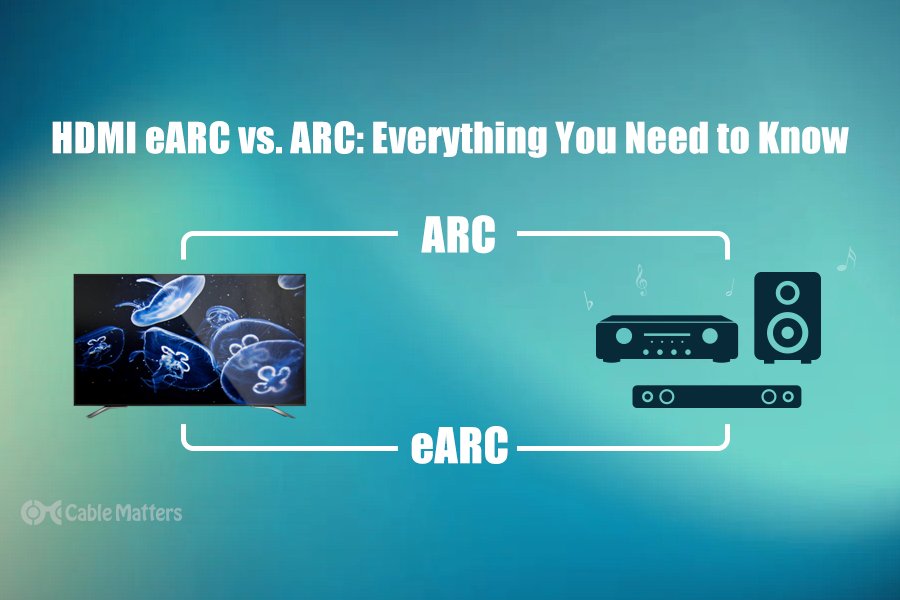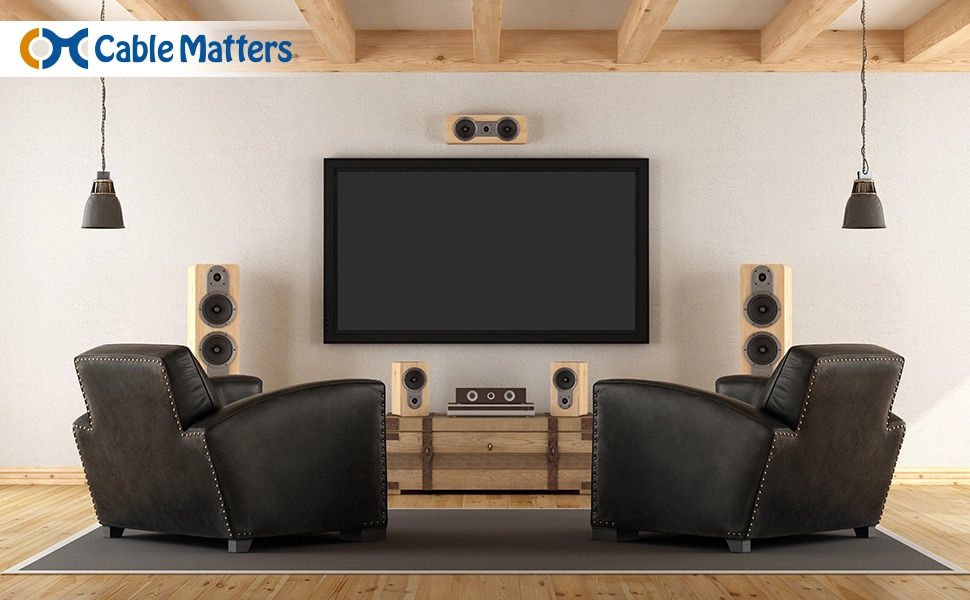
HDMI cables are one of the most popular consumer solutions for connecting video and audio sources to compatible displays and sound systems. One of the reasons that HDMI has been so beloved over many generations, is its support for the audio return channel, or ARC, technology, which allows it to simplify and streamline external A/V systems when connecting them to a TV and devices like games consoles, Blu-ray players, and desktop computers. With the advent of eARC technology, even more, features and capabilities were added to this useful tool.
As the newer technology, eARC can do things that ARC can’t, but does that mean you absolutely need to upgrade to the newest HDMI standard? Absolutely not. In fact, if you don’t have the hardware to take advantage of it, you’d be completely wasting your time and money.
To help you decide which generation of ARC technology is right for you, this is HDMI eARC vs. ARC, the definitive breakdown.
What is HDMI?
The High-Definition Multimedia Interface, or HDMI connector, is a common interface for transmitting compressed and uncompressed video and audio from a source device to a display of some kind. It’s been in use in consumer devices since 2004 and was originally designed to replace aging analog and digital interfaces, like VGA, DVI-D, and RGB Component. Today, it’s a universal solution for transmitting audio and video digitally from a range of devices, including the latest games consoles and desktop computers.
HDMI cables use a 19-pin arrangement with a standardized, non-reversible connector. The latest generation of the technology is HDMI 2.1, although HDMI 2.0 is still in use in a range of contemporary devices, and older HDMI cables are supported by more recent standards, so still see some use.
What is HDMI ARC?
HDMI audio return channel, or HDMI ARC, is a technology that was introduced with the HDMI 1.4 version of the standard. It was designed to make HDMI a capable replacement for existing audio cable connections between a television and an external A/V receiver or speaker system. HDMI ARC has much greater bandwidth than older audio cable solutions, like optical, and can therefore carry all the audio and video necessary for streaming services and physical media. That cuts back on the number of cables required in your A/V setup.
Better yet, HDMI ARC lets information travel both ways, so as well as using an HDMI cable to transmit audio from your TV to your A/V system, you can streamline your cables by having everything rout through your A/V setup (if it has enough HDMI connections). You connect your games console or Blu-ray player to your soundbar or audio system using an HDMI cable, then use another HDMI cable to connect to your TV. That way you cut out the additional cabling, making for a simpler, and tidier setup, whilst still being able to enjoy the audio through your audio setup, and the picture on your TV.
HDMI ARC also introduced support for Dolby Atmos, which allows for the vertical placement of sound in a surround sound setup, although only through the lossy Dolby Digital Plus codec.
What kind of cable do you need to use for ARC?
Due to HDMI cable backward compatibility, almost any HDMI cable can be used for HDMI ARC. However, that doesn’t mean you should use any old HDMI cable you have lying around. Since HDMI ARC was introduced with HDMI 1.4, your best bet is to use HDMI 1.4 cables or newer. These are typically marketed as “High Speed”, or 4K at 30Hz capable.
You also need to make sure your display and A/V system both support ARC, with some devices and TVs having specific ports designated for ARC and eARC, so check your port labels, or your manufacturer’s manual if you need extra help finding the right one.
What is HDMI eARC?
Enhanced audio return channel, or eARC, is the evolution of ARC technology and an exclusive feature of HDMI 2.1 cables and compatible devices. It takes advantage of the additional bandwidth of HDMI 2.1 cables to offer support for uncompressed 5.1 and 7.1 surround sound audio, as well as enhanced surround sound technologies like the Dolby TrueHD version of Dolby Atmos, and DTS:X.

What kind of cable do you need to use for eARC?
Like ARC, eARC needs an HDMI cable, but unlike ARC, there is only one generation of HDMI cable that was designed to support eARC, and that’s HDMI 2.1. This latest standard of HDMI cable introduced much higher data rates, unlocking higher resolution and refresh rate support, but it also added a number of useful features for TV viewers and console gamers alike.
It has better support for variable refresh rate (VRR), support for quick media switching, and quick frame transport. Crucially for this discussion, however, it added eARC support. You’ll need an A/V system and TV that have their own eARC ports to make the most of it, but most modern TVs have at least one HDMI 2.1 port with eARC support, and higher-end TVs from recent generations have had some measure of eARC support for years.
The one caveat to this is that the HDMI Forum – the collection of companies that have an interest in HDMI’s development – has said that older, HDMI 1.4 High Speed with Ethernet and HDMI 2.0 with Ethernet cables should also work with eARC. However, there’s no guarantee, and depending on cable quality, you may get mixed results.
It’s important that all components in your setup support eARC in some capacity, though. If your A/V receiver or your TV only supports ARC, you will automatically be downgraded to that technology, potentially leading to compression and a loss of surround sound audio features.
HDMI eARC vs. ARC isn’t really a fair comparison, because one is newer and better, but you do need to have the required hardware to take advantage of eARC, so you may be restricted to ARC because of the TV or devices you are trying to connect.
Frequently Asked Questions about eARC and ARC
If you’re looking to set up your home TV and A/V system with an audio return channel solution of some kind, here are some of the most frequently asked questions about HDMI eARC vs. ARC, so you can go in fully prepared.
How do I know if my HDMI cable is eARC?
No HDMI cable is specifically rated for eARC, but HDMI eARC is only fully supported by HDMI 2.1 cables, so if your cable is an HDMI 2.1 cable, then it should support eARC without a problem.
However, if you don’t know what HDMI version your cable is, it can be a little tricky to find out. Some HDMI cables have labels to tell you their version, so look out for those. Some also have a resolution printed on them, such as 4K, or 8K. In the case of 8K, chances are you have an HDMI 2.1 cable, in which case it should support eARC as long as you connect it to a compatible display and device.
The only way to know for sure if you have a cable that is compatible with eARC is to test it. If you plug your unknown HDMI cable into a TV and device that can support 4K resolution and up to 120Hz refresh rates, then simply setting the TV to different settings will confirm your HDMI cable’s generation. If it can only manage 4K at 30Hz or less, it’s HDMI 1.4. If it can manage up to 60Hz, but no more, it’s HDMI 2.0, and if it can manage the full 4K 120Hz, then it is HDMI 2.1 and compatible with eARC.
Do older HDMI cables support eARC?
Technically, HDMI High Speed cables with Ethernet can support eARC technology, as the HDMI Forum has stated. However, there is no guarantee that those older cables are built to the kind of standards of modern HDMI 2.1 cables, and therefore the support is not guaranteed; even if it works, your experience may be sub-par.
The only real way to enjoy the benefits of eARC is with an HDMI 2.1 Ultra High Speed cable. There are ways to identify if your cable is HDMI 2.1 (and therefore eARC) compatible, as described above, but typically it’s better to simply buy a new HDMI 2.1 cable you know is ready for eARC.
Can you hear the difference between ARC and eARC?
When it comes down to it, the HDMI eARC vs. ARC debate really depends on how you’re using them, and how keen your ear is. If you aren’t using surround sound or some of the advanced audio features that are exclusive to eARC, then the audio you hear will sound almost identical. It would be the same if you were using an Optical cable solution instead.
However, if you are using 5.1 or 7.1 surround sound, and additional features like Dolby Atmos, then you may be able to tell the difference. ARC can only transmit compressed surround sound audio, whereas eARC has the bandwidth for uncompressed audio. That’s not to say ARC sounds bad, and clever compression algorithms mean that the end result still sounds good, but it will lack the lossless vertical sound placement enabled by TrueHD Dolby Atmos and DTS:X, and audiophiles will likely notice the compression.